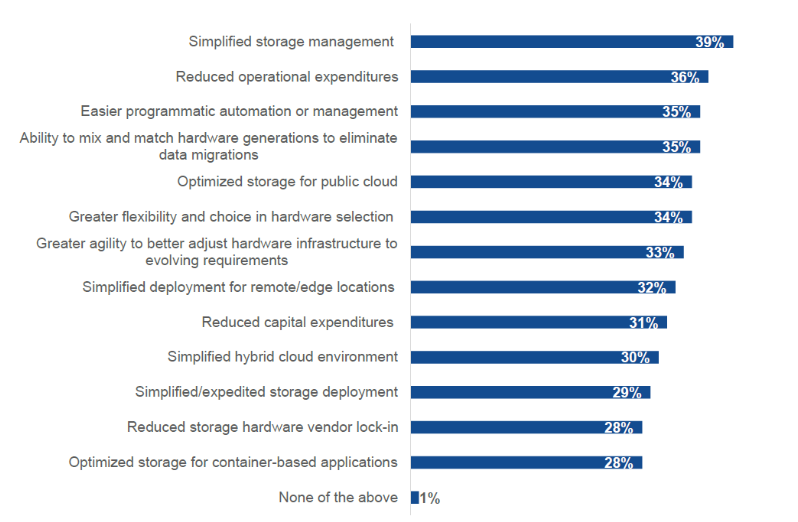E-commerce has transformed the way the world shops, and the convenience of online shopping has created immense opportunities for retailers. However, this growth makes it difficult to manage the vast amounts of data required to provide real-time insights and superior customer experiences. For architects of e-commerce platforms, architecting the data platform for performance, efficiency, flexibility and reliability is paramount. Your data platform is not just a functional necessity but a strategic asset that can drive business growth and scale. One cannot underestimate the role of eCommerce business storage in ensuring optimal online digital customer experiences and site performance during traffic spikes.
Why eCommerce Storage Can Make or Break Your Business
Effective eCommerce storage solutions play a big role in enabling real-time analytics, transactional and AI/machine learning (ML) workloads that empower your online retail business to monetize its data, transform operations and deliver superior customer digital experiences. Latency, measured in microseconds, is the enemy of your eCommerce platform, as slow-performing e-commerce storage systems can mean hundreds of thousands of dollars in lost transactions and abandoned shopping carts. Your storage must be reliable and highly performant even during fluctuating demand; events like Black Friday or unexpected social media trends can put a heavy load on your systems. Infrastructure that supports real-time data processing can be the deciding factor in staying competitive.
These challenges necessitate a modern approach to storage — one that is software-defined, scalable and cloud-ready. Modern cloud eCommerce platforms have strong appeal among sector leaders — especially those that have grown quickly and now have massive data environments that their legacy storage architectures, such as storage area networks (SAN) and direct-attached storage (DAS), struggle to support. It’s also popular among online retailers looking to drive cost efficiencies by building their own eCommerce cloud platform.
The challenge for platform architects, whether building their e-commerce storage platform on-premises or in the cloud, is to achieve scale and flexibility without compromising application and site performance. Many legacy storage systems, especially those architected for spinning disks, have performance limitations, resulting in data silos and expensive and time-consuming scaling strategies.
4 Storage Strategies for E-Commerce
Do you face traffic spikes or unpredictable surges triggered by unforeseen events or viral trends? Do you need to harness data effectively to swiftly grasp market trends and customer behaviors to adapt promptly and deliver tailored products and experiences?
Here are four e-commerce business storage strategies that stand out as foundational elements for success.
1 – Auto-Scale Services in Response to Demand
Cloud storage for e-commerce must be equipped to scale dynamically during unpredictable, peak demand periods to ensure superior digital customer experiences every time. Legacy storage architectures may not be built with “scale-out” principles. The result can either be lengthy and costly controller upgrades to meet changing requirements, which may involve downtime, or massive overprovisioning to provide longevity or account for demand spikes. Although some online retailers have deployed DAS or “just a bunch of flash” (JBOF) to cost-effectively boost performance at scale, this becomes problematic in terms of resiliency and efficiency.
Software-defined storage (SDS) is a game-changer for solving scaling limitations. SDS decouples storage management from physical hardware. This disaggregation provides flexibility and agility, enabling dynamic scaling in any direction, up or out.
Solutions like SDS allow dynamic scaling so you can adjust your storage needs in real time. This flexibility ensures that application and site performance remain consistent, regardless of fluctuations in user demand. Dynamic scaling is critical for seamless operations, especially in a sector where customer demands and market conditions can shift rapidly.
2 – Modernize Your Cloud eCommerce Platform for Efficiency
The cyclical nature of retail, coupled with sudden surges during promotional events or viral trends, makes capacity planning difficult. Overprovisioning storage resources to handle peak loads can lead to unnecessary costs while underprovisioning risks application performance bottlenecks and possibly timeouts. In addition, diverse data types require a storage system that can unify and process data effectively. Legacy systems often require significant manual intervention for provisioning, scaling, and maintenance, which slows the ability to respond to business needs. Balancing performance, reliability, and scalability with budget constraints is a constant challenge.
SDS enables data platforms that are not only efficient but also future-proof. Because SDS is disaggregated, it eliminates the need for overprovisioning to handle demand spikes cost-effectively and efficiently. Storage can be provisioned where and when needed, and built-in automation and data services reduce manual intervention. It can run on commodity hardware, which also significantly lowers storage costs.
If you build your online business on native cloud platforms and operate on a pay-as-you-go model may see the greatest cost-efficiency benefits. Good news, many SDS solutions support hybrid and multi-cloud environments for seamless integration with existing systems and cloud services like AWS and Azure. Building on cloud-native infrastructure enables online retailers to optimize their operational budgets and avoid buying expensive on-premises infrastructure. Another alternative is to architect a hybrid cloud model, bursting to the cloud for on-demand capacity or performance. This approach helps online retailers remain agile and ready to meet customer demands without the limitations imposed by traditional storage systems.
3 – Ensure 24/7/365 Site Availability and Reliability
Site availability and reliability are top priorities for any eCommerce business. There is immense pressure to maintain constant site availability and reliability. Unplanned outages, downtime or performance degradation directly impact revenue and customer trust. Building a platform where the data is available to the applications where and when needed is necessary to ensure seamless user experiences and business continuity. Legacy systems can introduce risks, including unplanned outages, supply chain disruptions when provisioning hardware and components, and slow recovery from disasters.
SDS can directly address these risks. Supply chain issues are mitigated because the software can run on any commodity hardware or cloud. Its integration with hybrid cloud and multi-cloud environments enables quick failover to alternate sites, reducing downtime in disaster scenarios. A persistent storage system can result in more uptime. Built-in resiliency, such as synchronous replication and snapshots, helps ensure high availability and data protection.
4 – Accelerate Data Collection and Transactions
Fast data collection and transaction processing are vital for eCommerce platforms to ensure real-time analytics and seamless customer experiences. However, legacy storage systems often introduce latency, slowing data collection and transaction processing. Overprovisioning storage to reduce latency increases costs and complexity without fully addressing performance needs.
SDS accelerates analytics workloads by delivering high throughput and IOPS, ensuring timely insights for better decision-making. Modern systems leveraging NVMe over TCP (NVMe/TCP) storage will deliver low consistent latency at scale, enabling instant data collection and rapid transaction processing. Many leading e-commerce companies already leverage it for efficiency and performance advantages.
The Future of eCommerce Storage
AI-driven and cloud-native applications, real-time analytics and increasing customer expectations necessitate storage solutions that are both powerful and adaptable. The core challenge is that many legacy storage architectures were not built for the 21st-century world of lightning-fast, turn-on-a-dime eCommerce, where data needs to be used and analyzed in real time. Software-defined storage offers the capabilities needed to build resilient, scalable, efficient, flexible, high-performance systems.

Source: Modern Storage Architectures for E-commerce whitepaper, Enterprise Strategy Group, a division of TechTarget, Inc., April 2024.
Data platform strategies that offer dynamic scaling, efficiency, site availability and reliability, and accelerated data pipelines can revolutionize your operations in the digital marketplace. By making an investment in a software-defined cloud storage eCommerce solution, you can achieve sustainable growth and deliver exceptional customer experiences. Embracing modern software-defined cloud architecture is no longer optional; it is necessary to thrive in today’s fast-paced online retail environment. As eCommerce grows, those prioritizing these strategies will be best positioned to succeed and lead.
Grow Your Online Retail Business with Lightbits Storage for eCommerce
Lightbits enables you to build an economical, high-performance eCommerce cloud platform that can scale easily to meet business growth and unpredictable user demand. Lightbits delivers software-defined, disaggregated storage clusters built on the power of NVMe/TCP.
As a software-defined solution, you gain the economics of using commodity servers and storage instead of legacy storage appliances. As a disaggregated replacement for DAS, you gain higher availability and increase resource utilization. And because the Lightbits cluster uses NVMe/TCP you get maximum performance without any specialized networking. With an eCommerce storage solution from Lightbits, you can maintain control over your data platform without the complexity or expense of traditional storage architectures.
Lightbits eCommerce storage for private clouds unifies resources so you can efficiently provision and manage storage like a SAN, with key enterprise data services included.
- High Availability. Clustered design eliminates service disruption on node or drive loss, while multi-zone synchronous replication provides business continuity.
- Dynamic Scalability. You can dynamically scale-out or shrink your Lightbits cluster easily to meet increased performance or capacity requirements.
- Snapshots and Clones. Lightbits provides built-in incremental snapshots, eliminating the need for third-party backup software, as well as efficient database clones for your DevOps teams.
- Multi-tenant. A single Lightbits cluster provides multi-tenancy for multiple heterogeneous environments. Lightbits Quality of Service (QoS) ensures your users won’t notice any service impacts.
- Flexible licensing. Lightbits cloud-based e-commerce solution licenses are portable between AVS, Azure, and on-premises deployments and can be used for any implementation model: all cloud, hybrid- or multi-cloud.
- Agile. Lift and shift workloads to any cloud and allocate storage on an as-needed basis.
Real-World Application of Cloud Storage – eCommerce
An Asia-Pacific (APJ) eCommerce giant commanding a multi-billion dollar market and managing millions of users, visits, and shipments daily, modernized its cloud eCommerce platform to scale efficiently and remain competitive globally. Their adoption of the cloud eCommerce solution from Lightbits exemplifies how software-defined storage (SDS) addresses challenges in such a high-stakes environment.
The organization faced inefficiencies with its previous eCommerce business storage, which relied on Just a Bunch of Disks (JBOD) and Just a Bunch of Flash (JBOF). Key issues included:
- Low storage resource utilization due to thousands of drives across multiple servers.
- An inability to independently scale storage from compute.
- The a need for high-performance, low-latency storage to support intensive database workloads, including MySQL, MongoDB, Kafka, and Redis, within a dense Kubernetes (K8s) environment.
The company’s transition to Lightbits’ SDS with NVMe/TCP resulted in performance gains of 25–30% per node and improved data replication scenarios. The enhanced agility supplied by the data platform ensured rapid response to the eCommerce platform’s growing operational demands. By replacing legacy DAS architecture with Lightbits’ SDS, the eCommerce leader achieved the speed, reliability, and scalability needed to drive Big Data Analytics, enhance customer experience, and maintain its market leadership in the fast-paced digital economy.
Adopting Lightbits SDS delivered:
- Flexibility: Seamless operation across any cloud or hardware configuration.
- Scalability: Efficient scaling both vertically and horizontally.
- Efficiency: Thin-provisioning and compression improved resource utilization while automated provisioning simplified management.
- Agility: Quick adjustments to storage needs and easy portability of workloads across clusters or clouds. They can move storage services where and when they are needed.
- High Availability: Persistent storage volumes ensured consistent performance during K8s pod or hardware failures.
For this e-commerce business, their annual mega sales event represents a critical moment—millions of transactions are processed over a few days, with intense traffic spikes. This year, their infrastructure handled record-breaking sales volumes without a single hitch.
Visit the Lightbits blog to read more about this eCommerce organization’s success story.
Additional resources:
- Customer case study: Lightbits Powers One of the World’s Largest eCommerce Platforms
- Solution Brief: Lightbits Cloud Storage for eCommerce
- Whitepaper: Modern Storage Architectures for eCommerce

